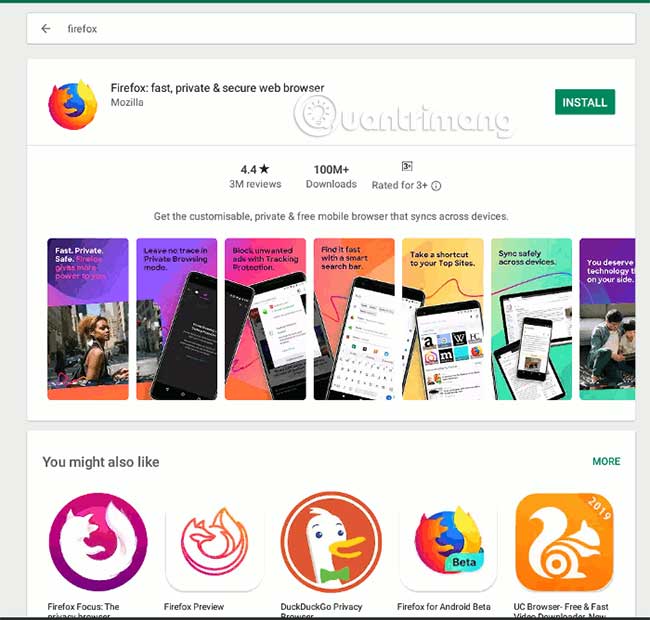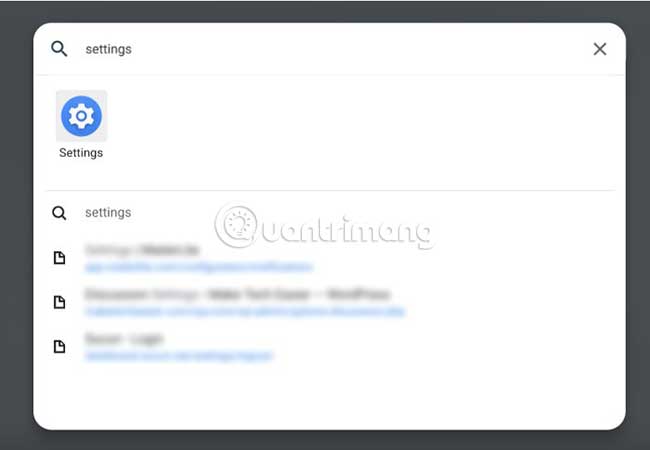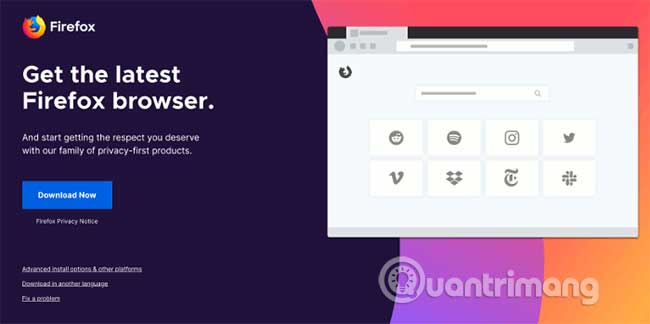How to install Firefox on a Chromebook
Chromebooks run Chrome OS, basically the Google Chrome browser. When you power on your Chromebook, the Chrome browser automatically launches so you can surf the web instantly.
But what if you are not a fan of Google Chrome? Or maybe you're wondering what Google is sneakily collecting data if you're using its browser.
Fortunately, there are several ways you can install Firefox on a Chromebook. Here is how you do this.
Instructions for installing Firefox on Chromebooks
- Install the Android Firefox application
- Install Firefox as a Linux application
- Install Firefox ESR
- Install standard Firefox
Install the Android Firefox application
Most new Chromebooks support Android apps, which means you can easily install Firefox from the Play Store.
1. Open Play Store on a Chromebook.
2. Do a Firefox search .

There are several Firefox browsers that you can choose, namely the standard Firefox, Firefox Focus and Firefox Preview.Firefox Focus is a minimal privacy browser that blocks a wide range of online trackers. Firefox Preview is a test browser of Mozilla. If you are looking for a browser with the most features, installing a standard Firefox browser is the best option.
3. After installation, you can use the Android version of Firefox.
Firefox for Android also supports extensions, although options are quite limited. Because it is a mobile browser by nature, you may not have a very good desktop user experience.
Install Firefox as a Linux application
If your Chromebook supports Linux applications, you can install the Linux version of the Firefox desktop.
To check if your Chromebook supports Linux apps, open the menu drawer and select Settings.

In Settings, search for 'linux'.
If you see the 'Linux (beta)' option , then your Chromebook can install Linux apps. Click it to activate (if you have not already done so).

Install Firefox ESR
The Linux container below is running Debian and only Firefox ESR is available in its repository. Open terminal in menu drawer. Enter the following command to install Firefox-ESR.
sudo apt install firefox-esr After installation is complete, you will see the Firefox icon in the dock. You can start using Firefox in Chromebook.
Firefox-ESR stands for Firefox Extended Support Release, this is a long-term support version. The fact that Firefox-ESR is a stable release, means it is suitable for business use.
Releases will be maintained for more than a year, with security updates coinciding with regular Firefox releases. New features in regular Firefox releases will only be offered in ESR in the next major release, after the end of the current release cycle.
Install the standard Firefox
If you want to use the regular Firefox release instead of Firefox ESR, here's a simple way to install it on a Chromebook.
1. First install Firefox-ESR. This will install the dependency files required by Firefox.
sudo apt install firefox-esr 2. Next, delete Firefox-ESR without deleting its dependencies:
sudo apt remove firefox-esr 3. Visit the Mozilla website and download Firefox to the Home folder in Linux. (Linux's Home folder is the 'Linux files' folder in the Files app.)

4. Extract the tar file to the Home directory with the following command in the terminal. (Change the file name of Firefox in the command below).
tar -xvjf firefox-68.0.2.tar.bz 
You should now see the Firefox folder .
5. Finally, we will create a Firefox desktop icon. In the terminal, enter the following command:
sudo nano /usr/share/applications/firefox.desktop In the editor, paste the following code:
[Desktop Entry] Name=Firefox Comment=Browse the World Wide Web GenericName=Web Browser X-GNOME-FullName=Firefox Web Browser Exec=/home/USERNAME/firefox/firefox %u Terminal=false X-MultipleArgs=false Type=Application Icon=firefox-esr Categories=Network;WebBrowser; MimeType=text/html;text/xml;application/xhtml+xml;application/xml;application/vnd.mozilla.xul+xml;application/rss+xml;application/rdf+xml;image/gif;image/jpeg;image/png;x-scheme-handler/http;x-scheme-handler/https; StartupWMClass=Firefox-esr StartupNotify=true Change USERNAME to your username in the Linux terminal. Your username is the name in the terminal, followed by '@penguin'. In the example case, the username is 'damienohwj'.

Save ( Ctrl + o ) and exit ( Ctrl + x ) nano editor.
6. You should now see a Firefox icon in the menu drawer. (If not, reboot the Chromebook.) Click on it and the Firefox browser will launch. It will also automatically update in the future.
Although the Chrome browser is the default browser in Chromebooks, that doesn't mean you have to be 'stuck' with it. With support for Android and Linux applications, you now have options to install the browser you want, including Firefox. If you like Opera or Vivaldi, you can also install them.
Hope you are succesful.
 8 ways to fix the problem of not being able to install Firefox on Windows
8 ways to fix the problem of not being able to install Firefox on Windows How to install Kodi on a Chromebook
How to install Kodi on a Chromebook How to install iTunes on a Chromebook
How to install iTunes on a Chromebook How to install the Chrome utility for Firefox
How to install the Chrome utility for Firefox FireFox 54 version improves performance, speed, and security enhancement
FireFox 54 version improves performance, speed, and security enhancement